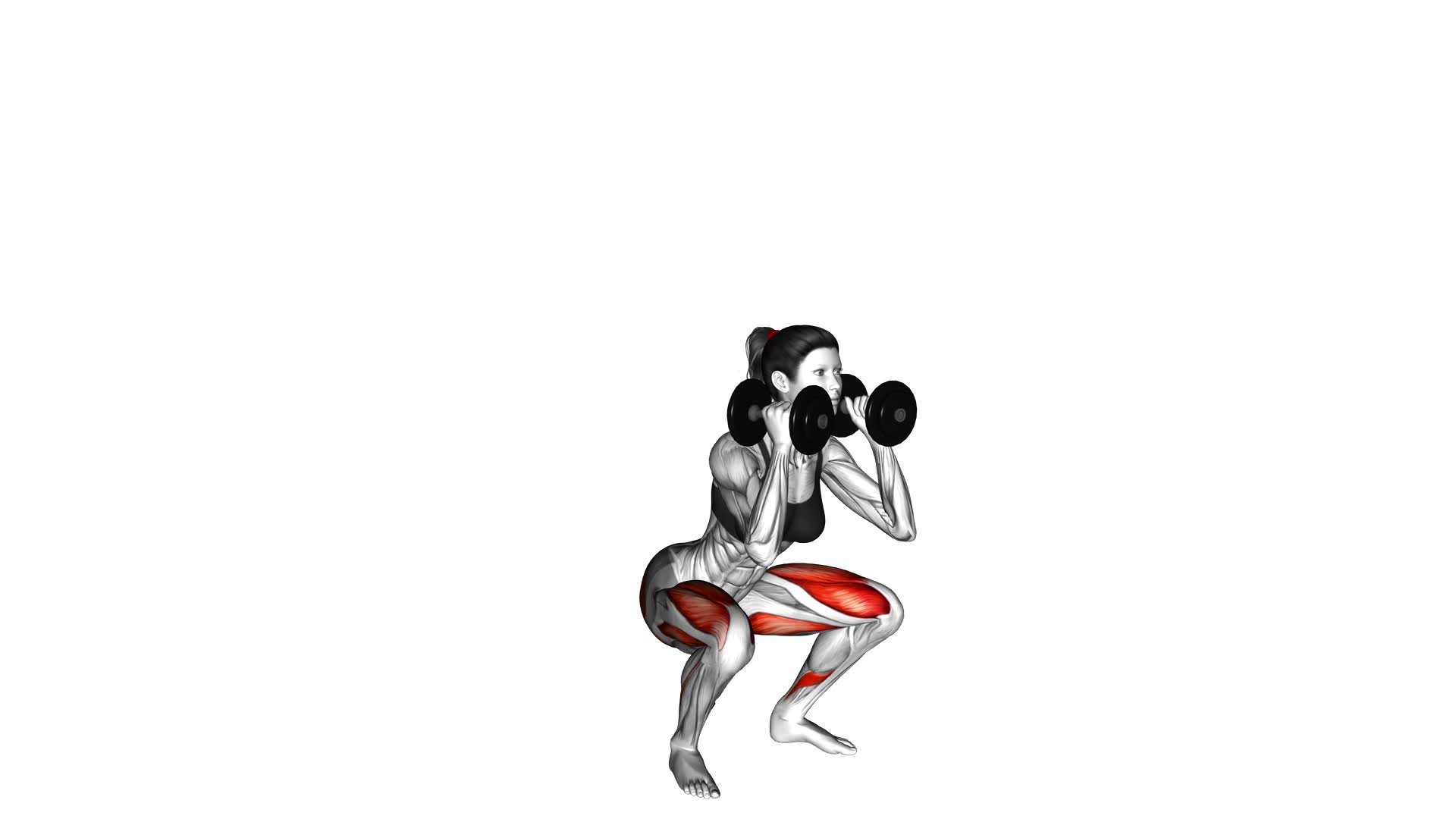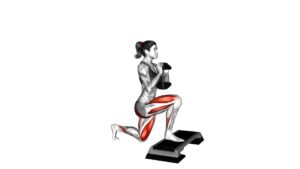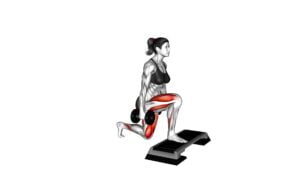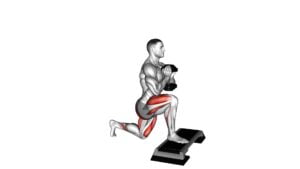Dumbbell Front Squat (female) – Video Exercise Guide & Tips

Are you looking to strengthen and tone your lower body?
Watch This Exercise Video
The dumbbell front squat is a fantastic exercise that targets your quads, glutes, and core all at once.
In this video exercise guide, we'll show you the proper form and technique to maximize your results.
Not only will you learn the benefits of incorporating dumbbell front squats into your routine, but we'll also share common mistakes to avoid and advanced variations for progression.
Get ready to level up your fitness game!
Key Takeaways
- Proper dumbbell front squat form includes standing with feet shoulder-width apart, holding dumbbells at the sides with palms facing inward, engaging the core, and maintaining a tall posture while bending the knees and pushing the hips back until the thighs are parallel to the ground.
- Dumbbell front squats offer benefits such as improved balance, increased core strength, enhanced lower body strength, toned leg muscles, and improved functional strength and stability.
- Common mistakes to avoid when performing dumbbell front squats include allowing the knees to cave inward, rounding the lower back, using weights that are too heavy, rushing through the exercise, and not maintaining proper form and technique.
- Advanced variations for progression in dumbbell front squats include pistol squats, goblet squats, Bulgarian split squats, which target additional muscle groups and increase the challenge and intensity of the exercise.
Proper Dumbbell Front Squat Form
To perform the dumbbell front squat with proper form, you should start by gripping two dumbbells and standing with your feet shoulder-width apart. This exercise is a great way to target several key muscle groups, including your quadriceps, hamstrings, glutes, and core.
To begin, hold the dumbbells at your sides, palms facing inward. Engage your core and maintain a tall posture throughout the movement.
Next, initiate the squat by bending your knees and pushing your hips back, as if you were sitting into a chair. Keep your chest lifted and your gaze straight ahead. As you lower your body, ensure that your knees track over your toes and don't collapse inward. Lower until your thighs are parallel to the ground, or as deep as your mobility allows.
To return to the starting position, push through your heels and extend your knees and hips simultaneously. Keep your core engaged and maintain a controlled, steady movement. Exhale as you straighten your legs and return to the standing position.
Benefits of Dumbbell Front Squats
While performing dumbbell front squats, you can experience numerous benefits that can improve your lower body strength and overall athletic performance. Here are some of the benefits you can expect:
- Improving balance: Dumbbell front squats require you to maintain a stable position while holding the weights in front of your body. This challenges your balance and helps to strengthen the muscles responsible for stability. As you continue to practice this exercise, your balance will improve, making you more stable and confident in other activities.
- Increasing core strength: The front squat places a significant demand on your core muscles to keep your torso upright and stable. By engaging your core throughout the exercise, you'll strengthen your abs, obliques, and lower back muscles. This increased core strength not only enhances your squat performance but also improves your overall functional strength and stability.
- Enhancing lower body strength: Dumbbell front squats primarily target your quadriceps, hamstrings, and glutes. By consistently performing this exercise, you'll develop stronger and more toned leg muscles. This improved lower body strength won't only help you in various sports and activities but also in everyday movements like walking, climbing stairs, and carrying heavy objects.
Incorporating dumbbell front squats into your workout routine can provide you with these benefits and more. Remember to start with lighter weights and gradually increase the load as your strength improves.
Common Mistakes to Avoid
To avoid common mistakes during dumbbell front squats, focus on maintaining proper form and technique.
One common mistake is allowing the knees to cave inward during the squat. This can put unnecessary stress on the knees and lead to injury. Instead, make sure to keep your knees in line with your toes throughout the movement.
Another mistake to avoid is rounding the lower back. This can lead to strain and discomfort. Keep your chest up and your back straight throughout the exercise.
Additionally, it's important to avoid using weights that are too heavy. This can compromise your form and increase the risk of injury. Start with lighter weights and gradually increase the load as your strength improves.
Lastly, rushing through the exercise is another mistake to steer clear of. Take your time and focus on performing each rep with control and proper technique.
Advanced Variations for Progression
Looking to take your dumbbell front squats to the next level? How can you progress and challenge yourself further? Here are three advanced modifications and alternative exercises that will help you step up your game:
- Pistol Squats: This exercise targets your quads, hamstrings, glutes, and core muscles. Start by holding the dumbbells at your sides, then lift one leg off the ground and extend it forward. Slowly lower your body down into a squat position while keeping your raised leg straight. Push through your heel to return to the starting position and repeat on the other leg.
- Goblet Squats: This variation involves holding a single dumbbell vertically in front of your chest. As you squat, keep your elbows pointing down and close to your body. This exercise places more emphasis on your quads and core muscles, while also improving your upper body strength and stability.
- Bulgarian Split Squats: Stand facing away from a bench or step with one foot resting on it, and hold a dumbbell in each hand. Lower your body down into a lunge position, keeping your front knee aligned with your ankle. Push through your front heel to return to the starting position and repeat on the other leg. This exercise targets your quads, hamstrings, glutes, and improves your balance.
By incorporating these advanced modifications and alternative exercises into your routine, you can continue challenging yourself and making progress with your dumbbell front squats.
Now, let's move on to the next section and discuss some useful tips for incorporating dumbbell front squats into your workout routine.
Tips for Incorporating Dumbbell Front Squats Into Your Workout Routine
To effectively incorporate dumbbell front squats into your workout routine, consider the following tips.
If you're a beginner, start with lighter weights and focus on proper form and technique. This will help you build a strong foundation and prevent injuries. Begin with a weight that allows you to perform 8-12 reps with good form. As you become more comfortable and confident, gradually increase the weight to challenge yourself. Aim to increase the weight by 5-10% each week to continue progressing.
In addition to increasing the weight, you can also vary the repetitions and sets to add variety to your routine. For example, you can perform 3 sets of 10 reps one week, and then 4 sets of 8 reps the next week. This will help prevent plateaus and keep your muscles guessing.
It's important to listen to your body and not push yourself too hard. If you experience any pain or discomfort, stop immediately and consult with a professional. Remember to always warm up before starting your workout and stretch afterwards to prevent injuries and aid in recovery.
Incorporating dumbbell front squats into your workout routine can be a great way to strengthen your lower body and improve your overall fitness. By following these tips and gradually increasing the weight, you'll continue to challenge yourself and see progress over time.
Frequently Asked Questions
How Heavy Should the Dumbbells Be for a Female When Performing Dumbbell Front Squats?
When performing dumbbell front squats, it's important to choose the right weight for you as a female. The weight should challenge you without compromising your form.
Start with lighter dumbbells and gradually increase the weight as you get stronger and more comfortable with the exercise. Remember, it's better to start lighter and work your way up than to jump into heavy weights and risk injury.
Can Dumbbell Front Squats Be Performed Without a Squat Rack?
Yes, dumbbell front squats can be performed without a squat rack. To modify for beginners, start with lighter weights or even bodyweight squats. As you gain strength and confidence, gradually increase the weight.
However, it's important to note that dumbbell front squats may not be suitable for individuals with knee issues. If you have knee problems, it's best to consult with a healthcare professional or a certified trainer for alternative exercises that won't exacerbate your condition.
Should I Perform Dumbbell Front Squats Before or After Other Lower Body Exercises in My Workout Routine?
To maximize the benefits of incorporating dumbbell front squats into your lower body strength routine, it's advisable to perform them as a main exercise rather than as a warm-up.
By placing them at the beginning of your workout, you can ensure that your muscles are fresh and ready to tackle the exercise with proper form and intensity.
This will help you build strength, improve lower body stability, and increase overall power.
Are Dumbbell Front Squats More Effective Than Barbell Squats for Targeting the Quadriceps?
Dumbbell front squats and barbell squats both target the quadriceps, but are they equally effective? When comparing dumbbell front squats to barbell squats for quad development, there are a few key differences.
Dumbbell front squats can provide a greater range of motion and increased core activation, making them beneficial for women looking to strengthen their quads.
However, barbell squats allow for heavier loads, which can also stimulate quad growth.
Ultimately, incorporating both exercises into your routine may yield the best results.
Can Dumbbell Front Squats Help Improve My Balance and Core Strength?
Dumbbell front squats can definitely help improve your balance and core strength. By holding the dumbbells in front of your body, you're forced to engage your core muscles to maintain stability throughout the exercise. This helps strengthen your abdominal and lower back muscles, leading to improved balance.
If you're looking for alternative exercises to further enhance your balance and core strength, you can also try exercises like single-leg squats, planks, and Russian twists.
Conclusion
In conclusion, the dumbbell front squat is an effective exercise for targeting the lower body muscles. By maintaining proper form and avoiding common mistakes, you can maximize the benefits of this exercise, including improved leg strength and stability.
To further challenge yourself, try advanced variations for progression. Incorporating dumbbell front squats into your workout routine can help you achieve your fitness goals and enhance overall strength and endurance.

Author
Years ago, the spark of my life’s passion ignited in my mind the moment I stepped into the local gym for the first time. The inaugural bead of perspiration, the initial endeavor, the very first surge of endorphins, and a sense of pride that washed over me post-workout marked the beginning of my deep-seated interest in strength sports, fitness, and sports nutrition. This very curiosity blossomed rapidly into a profound fascination, propelling me to earn a Master’s degree in Physical Education from the Academy of Physical Education in Krakow, followed by a Sports Manager diploma from the Jagiellonian University. My journey of growth led me to gain more specialized qualifications, such as being a certified personal trainer with a focus on sports dietetics, a lifeguard, and an instructor for wellness and corrective gymnastics. Theoretical knowledge paired seamlessly with practical experience, reinforcing my belief that the transformation of individuals under my guidance was also a reflection of my personal growth. This belief holds true even today. Each day, I strive to push the boundaries and explore new realms. These realms gently elevate me to greater heights. The unique combination of passion for my field and the continuous quest for growth fuels my drive to break new ground.







